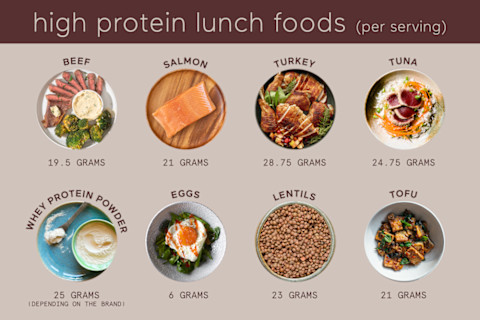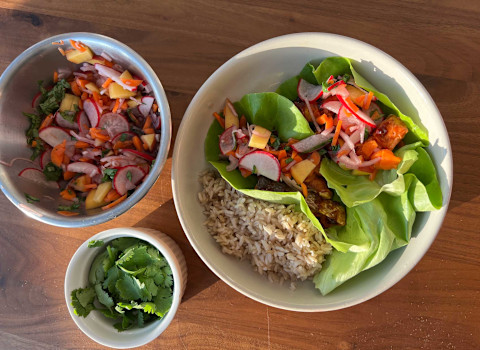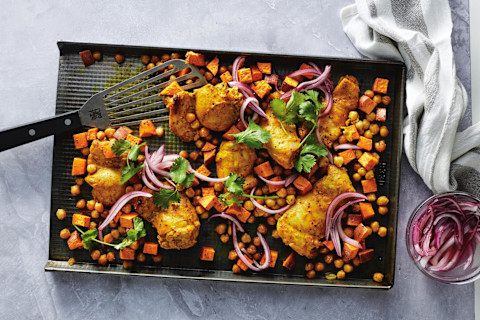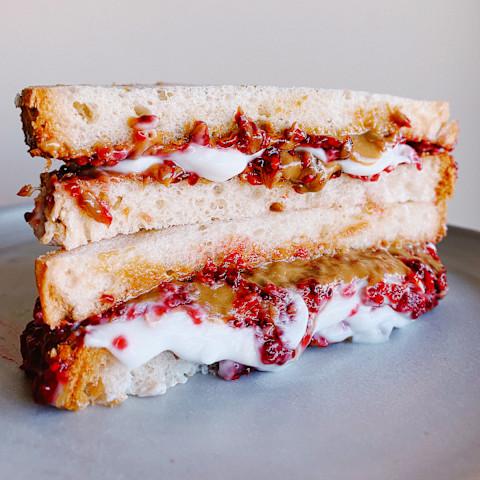
For too long, "healthy lunch" has been synonymous with "sad desk salad." Our midday meals should be tasty, satisfying, and rich in nutrients that can fuel us through busy afternoons. If yours is lacking in any of these departments, you may need to add more protein to your plate.
Today, we're exploring how much protein you should aim to eat for lunch and what types of protein are best for muscle growth and whole-body health. And we're sharing 15 delicious lunch recipes that pack at least 20 grams of high-quality protein per serving.
The need-to-knows
- Your protein needs may be higher than you think: Emerging research shows that most active people will benefit from eating at least 100 grams of protein a day for optimal metabolic health, muscle function, and more.
- There are benefits of eating 20+ grams of protein at lunch: Splitting up your protein intake throughout the day and getting 20 to 30+ grams per meal (including lunch) can make it easier to hit your daily goals, build muscle, stay full, and resist cravings.
- Animal proteins are a more complete protein source: Animal proteins contain all the amino acids our bodies need to produce muscle in the right amounts. Plant proteins usually don't, so vegetarians and vegans need to be more intentional about working a variety of protein sources into their diet.
High-protein lunch benefits
When it comes to protein, the most important thing to monitor is your overall daily intake. As long as you're eating enough daily protein for optimal health (over 100 grams a day for most people), when you eat it doesn't matter as much.
"Most important is the total protein intake," Alyssa Olenick, Ph.D., an exercise physiologist and sports nutritionist, tells mindbodygreen. That said, "it's ideal for us to consume our protein across the day, in each of the meals that we're eating."
Research shows that eating a higher-protein lunch1 can make it easier to increase your total daily protein intake. Spreading your protein throughout the day also helps ensure that you're constantly stimulating muscle protein synthesis (MPS), or the creation of new muscle.
High-quality protein (that contains 2-3 grams of leucine) stimulates an MPS response for around two to three hours2. As nutritionist Maggie Moon, M.S., R.D., points out, by only eating a high-protein dinner (as many Americans do), you're limiting the number of hours your body can construct muscle.
This isn't just good for bodybuilders—being adequately muscled supports a healthy metabolism and insulin sensitivity, and sets you up for healthier aging.
"It's important to think about how to get more protein throughout a day in more moderate doses... We want to make sure that we're restoring our protein stores every three to five hours," explains Moon.
Protein is also very satiating; it will keep you full for longer than carbs or fats.3 This makes it an essential part of a balanced lunch that will help you cruise through the afternoon slump.
Summary
High-protein lunch staples

- Beef: 19.5 grams of protein (1.5 grams of leucine) per 4-oz serving of 80% lean meat ground beef4
- Salmon: 21 grams of protein (1.7 grams of leucine) per 4-oz serving of wild-caught Atlantic salmon5
- Turkey: 28.75 grams of protein (2.4 grams of leucine) per 4-oz serving of cooked ground turkey6
- Tuna: 24.75 grams of protein (2 grams of leucine) per 4-oz serving of bluefin tuna7
- Whey protein powder: 25 grams of protein (2.5 grams of leucine) per serving, depending on the brand
- Eggs: 6 grams of protein (0.5 gram of leucine) per large whole egg 8
- Lentils: 23 grams of protein (1.75 grams of leucine) per ½-cup serving of dried pink or red lentils9
- Tofu: 21 grams of protein (1.75 grams of leucine) per ½-cup serving of firm tofu10
Recipes
These lunch recipes all pack at least 20 grams of protein—plus plenty of healthy fats and fiber. They can all be made ahead of time to make your lunch hour a breeze:
Curried Chicken & Kale Salad With Creamy Harissa Dressing
Approximate protein per serving: 56 grams
Goat cheese and harissa are a match made in heaven, and this flavorful salad is proof. This recipe makes four servings so you can have a delicious and protein-packed lunch on hand all week long. Bonus: It's safe for those with gluten sensitivities.
Spicy-Sweet Salmon Lettuce Wraps With Peach Slaw

Approximate protein per serving: 21 grams
These lettuce wraps get high-quality protein from sockeye salmon and make for an easy summertime lunch, when peaches are at their peak. "I love recommending fatty fish because those omega-3s are so important for brain health," says Moon. Pro tip: Leave the skin on—it's a concentrated source of these healthy fats!
Breakfast-for-Lunch Sausage Burrito
Approximate protein per serving: 25 grams
This humble breakfast burrito offers an easy way to get protein (from the eggs and sausage), fiber (from the veggies), and healthy fats (from the avocado). And it's so easy to make your own: Swap in any fresh or frozen produce you have on hand, and feel free to replace the sausage with black or pinto beans for a vegetarian-friendly twist.
Wholesome Millet Burgers
Approximate protein per serving: 20 grams
Not your typical veggie burger, this plant-based recipe leans on millet—a member of the cereal family that's rich in copper, folate, magnesium, and B-complex vitamins—for a rich taste and satisfying texture. Make a big batch on Sunday and eat them as a sandwich or topped on salad during the week. You'll need to make a pretty hefty pattie to reach 20 grams of protein (this recipe comes to around 45 grams total), but you can top yours with an egg or two for an additional 6-12 grams of leucine-rich protein.
Dilly Chicken Salad on Toast
Approximate protein per serving: 30 grams
Chicken salad can be bland, but trust Melissa Ben-Ishay (of Baked By Melissa fame) to come up with a twist you'll actually crave every day. Don't skimp on the dill and pickles—they give this recipe its big flavor.
Hearty Minestrone With Meatballs
Approximate protein per serving: 23 grams
For a cozy and satisfying winter lunch that comes together surprisingly quickly, you can't beat minestrone. This recipe calls for pork or dark meat turkey, but feel free to swap in any type of meat you have on hand.
Sheet Pan Turmeric Chicken With Sweet Potatoes & Chickpeas

Approximate protein per serving: 26 grams
For an easy set-it-and-forget-it lunch, try this sheet pan chicken and chickpea bake, jazzed up with anti-inflammatory turmeric.
Chicken Congee
For a warm hug in lunch form, try this chicken congee (rice porridge) recipe. You can get creative with the toppings: Dress with chopped ginger, scallions, chives, and/or soy sauce for added complexity.
Approximate protein per serving: 26 grams
Marinated Chickpeas
Approximate protein per serving: 20 grams
Soaking chickpeas in a bath of garlic, bay leaves, and chilis gives them a punchy quality that only gets better the longer they sit in the fridge. Whip up a batch for lunch to enjoy on top of lettuce or in a pita or wrap. Swap the honey for the sweetener of your choice to make this recipe vegan. Up the protein content by topping them with the yogurt of your choice.
Grains & Greens Bowl
For a simple plug-and-play lunch that packs a nutritional punch, Moon loves grains and greens bowls. "They're such a simple way to get a balanced meal with whole grains, leafy greens, and plant or animal protein."
Approximate protein per serving: Depends on the recipe
Raspberry Chia Jam Sandwich

Approximate protein per serving: 21 grams
Who said PB&Js are for kids? This more nutrient-dense take combines homemade chia jam, rich sunflower butter, and coconut yogurt for some added protein. And don't worry—it's just as delicious as the original.
Chicken Crust Taco Pizza
Approximate protein per serving: 22 grams
This keto-friendly recipe uses ground chicken thigh as a higher-protein alternative to a standard crust. From there, you can have fun with the toppings, but you can't go wrong with the classic three-cheese and black olives.
French Lentils & Fennel Salad
Approximate protein per serving: 20 grams
This recipe combines lentils and smoked salmon for a lunch salad that will actually keep you fueled until dinner. Perfect packed lunch for the office, found.
Thai Beef Stew
Approximate protein per serving: 44 grams
Put your slow cooker to great use with this Thai beef stew that gets its rich flavor from tomato paste, red curry paste, and fish sauce, brightened up by broccoli, carrots, and jicama.
Make-Ahead Poke-ish Bowl
Approximate protein per serving: 45 grams
This poke-inspired bowl trades raw fish for cooked salmon to make it more suitable for a make-ahead lunch that's packed with tang and texture.
How much protein do you need for lunch?
The amount of protein you need per day (and per meal) will depend on factors like your weight, age, activity level, and even gender.
However, research suggests that eating at least 20-30 grams of high-quality protein in each meal11 is a good target for most people. While 20 grams of protein is a minimum to engage MPS, you don't necessarily need to limit yourself to 30 grams.
"An interesting study12 just came out finding that you can eat 100 grams of protein at once and you will still maximize protein synthesis," says Olenick. Researchers found that eating higher quantities of protein will boost amino acid availability for longer, increasing the duration of muscle protein synthesis. "There's not this 30- to 40-gram ceiling that a lot of people thought that it was useless to go above."
Protein quality is also important to consider—especially if you're vegan or vegetarian. "The human body doesn't require a specific protein source. The human body requires specific amino acids," says Moon.
Animal proteins contain all the amino acids that the human body requires to build muscle in the correct amounts, making them complete proteins. Plant proteins tend to be low in at least one essential amino acid, so they're incomplete. It's important to eat a wide variety of them to ensure you're getting the amino acids you need over the course of a day.
Nutrition researchers used to think that you need to eat plant proteins together in one meal to make them complete, but that theory has been debunked. "Studies prove13 that if we have some amino acids at lunch, but they are not complete, we can get them somewhere else in our day and still 'complete' those proteins," says celebrity dietitian and nutrition therapist Kim Shapira M.S., R.D.
The one exception may be the amino acid leucine. Research shows that it takes 2-3 grams of leucine to "turn on" the MPS response, so it's important to hit this threshold in each meal to build muscle. This is more difficult to do as a vegan or vegetarian—but not impossible. It may just require consuming larger servings of protein14 in one sitting.
Summary
Other perspectives on high-protein lunches
Some argue that it's not beneficial to eat at least 20 grams of protein for lunch, pointing to the Recommended Dietary Allowance for protein (which is quite low) as proof.
However, a growing body of research indicates that while the RDA for protein (0.8 grams per kilogram of body weight) is enough to protect us from major protein deficiencies, it isn't enough to improve our health15. When combined with resistance training, higher protein intakes may help prevent age-related sarcopenia (the loss of muscle mass) and support a healthy metabolism.
There are also mixed opinions out there about how much of the amino acid leucine we should be consuming at lunch daily. Some argue that leucine can actually speed up the aging process due to its effect on mTOR, a signaling system involved in muscle protein synthesis. There is some evidence that elevated mTOR levels increase cancer risk16.
However, eating a serving of protein at lunch causes mTOR to go up and down in a controlled, natural rhythm over a few hours. It doesn't lead to chronic elevation, so we'd argue that eating more leucine at lunch (at least 2.5 to 3 grams) is the way to go if you want to promote healthy and strong aging. You can find meaningful amounts of leucine in all animal proteins as well as some plant proteins like lentils and tofu.
The mindbodygreen POV
Getting enough protein throughout the day is essential for whole-body health. For lunch, you should aim to get at least 20 grams of protein (and 2.5 grams of leucine) through either animal protein or a high-quality plant protein like tofu or lentils.
Pair your protein with complex carbs, colorful vegetables, and healthy fats for a balanced meal that will keep you fueled all afternoon.
This doesn't apply to you if:
Higher-protein lunches won't be right for everyone. Those with kidney damage may need to follow a lower-protein diet, for example. Food needs are highly individual so check in with your doctor if you have questions.
FAQ
How can I get 40 grams of protein for lunch?
Topping your lunch with 1-2 servings of Greek yogurt or eggs can bring additional protein and help you hit the 40-gram threshold. Consider topping your burrito bowl with a few eggs or putting a dollop of yogurt on your chicken stew to easily up the protein of your meal. Here are a few other tips on how to eat more protein in a snap.
What is a high-protein lunch for muscle gain and fat loss?
Compiling a high-protein, low-carbohydrate meal might be your best bet if fat loss and muscle gains are your goals. Pairing lean proteins with some complex carbohydrates and healthy fats will help you lose fat while building muscle. Consider an open-faced salmon burger with veggies and guacamole or chicken salad with lettuce wraps. If muscle growth is your goal, you'll also need to do resistance training at least a few times a week.
The takeaway
Lunch is a great opportunity to get closer to meeting your daily protein requirements. Aim to eat at least 20 grams of high-quality and leucine-rich protein for lunch to build muscle and support healthy aging. Always craving brunch?
Here are a few high-protein breakfast recipes that also make for great midday meals.
16 Sources
- https://pubmed.ncbi.nlm.nih.gov/33190355/
- https://www.ncbi.nlm.nih.gov/pmc/articles/PMC3381813/
- https://www.tandfonline.com/doi/abs/10.1080/07315724.2004.10719381
- https://fdc.nal.usda.gov/fdc-app.html#/food-details/174036/nutrients
- https://fdc.nal.usda.gov/fdc-app.html#/food-details/173686/nutrients
- https://fdc.nal.usda.gov/fdc-app.html#/food-details/171506/nutrients
- https://fdc.nal.usda.gov/fdc-app.html#/food-details/173706/nutrients
- https://fdc.nal.usda.gov/fdc-app.html#/food-details/748967/nutrients
- https://fdc.nal.usda.gov/fdc-app.html#/food-details/174284/nutrients
- https://fdc.nal.usda.gov/fdc-app.html#/food-details/172475/nutrients
- https://www.ncbi.nlm.nih.gov/pmc/articles/PMC5872778/
- https://www.sciencedirect.com/science/article/pii/S2666379123005402
- https://www.ncbi.nlm.nih.gov/pmc/articles/PMC6893534/
- https://www.ncbi.nlm.nih.gov/pmc/articles/PMC7760812/
- https://pubmed.ncbi.nlm.nih.gov/26960445/
- https://www.ncbi.nlm.nih.gov/pmc/articles/PMC6387042/
